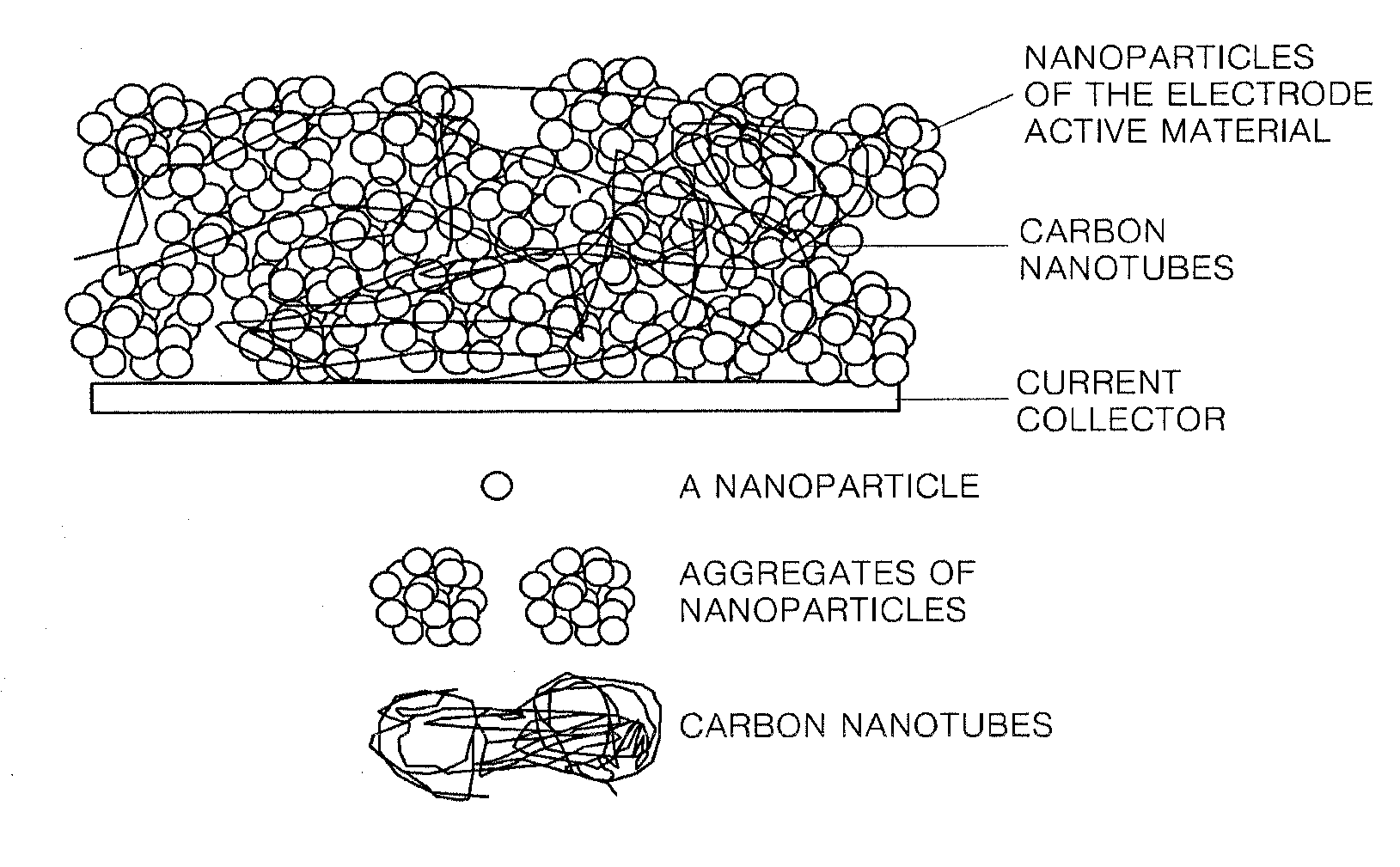Composites of self-assembled electrode active material-carbon nanotube, fabrication method thereof and secondary battery comprising the same
a technology of active materials and carbon nanotubes, which is applied in the direction of non-metal conductors, cell components, conductors, etc., can solve the problems of graphite limitations in use for a long time, deformation of the electrode active material, and inability to meet the requirements of electric vehicles and electric power storage, etc., to achieve the effect of improving mechanical strength and electron transfer
- Summary
- Abstract
- Description
- Claims
- Application Information
AI Technical Summary
Benefits of technology
Problems solved by technology
Method used
Image
Examples
example 2
Preparation of a Composite of Electrode Active Material of Self-Assembled TiO2 Aggregates-Double-Walled Carbon Nanotubes
[0112]A thin electrode layer was prepared in the same manner as in Example 1, except that the content of carbon nanotubes in the entanglement of the composite of electrode active material was doubled by increasing the dispensing rate of carbon nanotubes to about 2 μL / min. The time for electrospraying was controlled to prepare a thin electrode layer having a thickness of about 5 μm. Under these conditions, the weight ratio of the electrode active material nanoparticles to carbon nanotubes applied on the current collector is about 98:2.
[0113]FIG. 6 is an SEM photograph (×50,000) of the composite of electrode active material. It can be seen that the content of carbon nanotubes was greatly increased compared to FIG. 5. Referring to FIGS. 5 and 6, it can be seen that carbon nanotubes are present while characteristically encompassing the surface of the aggregate.
[0114]El...
example 3
Preparation of a Composite of Electrode Active Material of Self-Assembled TiO2 Aggregates-Multi-Walled Carbon Nanotubes
[0115]A TiO2 dispersion was prepared in the same manner as in Example 1. Multi-walled carbon nanotubes were dispersed in ethanol to prepare a dispersion, followed by mixing the TiO2 dispersion with the dispersion of carbon nanotubes to prepare a mixed single dispersion. As a result, it was found that TiO2 and carbon nanotubes in the mixed dispersion are present in an amount of 98% and 2% by weight, respectively, based on the total weight of the dispersion.
[0116]After the prepared dispersion was mounted on an electrospray device, electrospraying was performed. A voltage of about 23 kV, a needle of a size about 30 GA, a flow rate of about 30 μL / min, and a distance between the tip of the needle and a substrate of about 11 cm were employed for TiO2 electrospraying. A thin layer obtained after electrospraying may be subjected to pressing in order to increase the density ...
example 4
Preparation of a Composite of Electrode Active Material of LiFePO4 Aggregates-Double-Walled Carbon Nanotubes
[0121]In order to prepare LiFePO4 powders added with 1 mol % Nb, by a solid-state reaction method, a precursor composed of Li2CO3, Nb(OCH2CH3)5, FeC2O4.2H2O, and NH4H2PO4 mixed at a molar ratio of 0.495:0.01:1:1, was subjected to a ball milling in an acetone solvent for 24 hrs to obtain a mixed powder. After the mixed powder was dried, a heat treatment was performed under Ar atmosphere at about 350° C. for 10 hrs. Subsequently, a final heat treatment was performed at about 700° C. for 2 hrs to obtain a bulk powder of Li0.99Nb0.01FePO4 in which nanoparticles were aggregated.
[0122]A wet microbead milling in a solvent medium was performed on the bulk powder of Li0.99Nb0.01FePO4 obtained by the solid-state reaction method to prepare a dispersion in which fine nanoparticles were dispersed. Specifically, 2 g of the bulk powder of Li0.99Nb0.01FePO4 obtained by the solid-state reactio...
PUM
| Property | Measurement | Unit |
|---|---|---|
| sizes | aaaaa | aaaaa |
| length | aaaaa | aaaaa |
| internal diameter | aaaaa | aaaaa |
Abstract
Description
Claims
Application Information
 Login to View More
Login to View More - R&D
- Intellectual Property
- Life Sciences
- Materials
- Tech Scout
- Unparalleled Data Quality
- Higher Quality Content
- 60% Fewer Hallucinations
Browse by: Latest US Patents, China's latest patents, Technical Efficacy Thesaurus, Application Domain, Technology Topic, Popular Technical Reports.
© 2025 PatSnap. All rights reserved.Legal|Privacy policy|Modern Slavery Act Transparency Statement|Sitemap|About US| Contact US: help@patsnap.com



